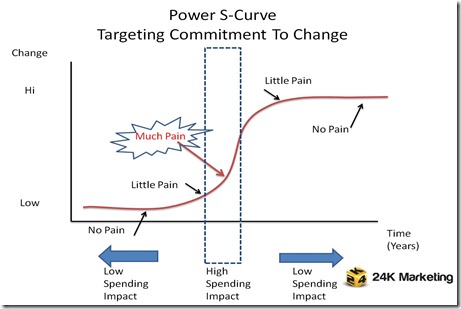Marketers should understand human behavior in order to be successful. One of the best visual models I have come across is the “S-Curve”, which represents how people make decisions that involve change (like buying something they never bought before). Decision points are the most efficient place to target a brand message – if they can be found.
Consumer Decisions and “Pain”
- All actions are preceded by decisions on which to act. In marketing language, purchases (actions) follow decisions to purchase.
- Decisions to change are usually preceded by “pain” — the realization that not moving forward will be far worse than doing nothing. Seeking “pleasure” is another motivator for change, but a much weaker one.
- People generally procrastinate when making decisions until the pain of not moving becomes severe. Decisions to buy a new car, get married, remodel your kitchen are made with a LOT of pondering. Even easy purchase decisions, like which cereal to buy, are pondered upon, and decisions are made after other options have been considered.
S-Curve and Marketing
The S-Curve represents the theory that decisions are made very quickly, but often after prolonged periods of awareness, without any action. Pain is elevated by a triggering event. A doctor’s diagnosis of heart disease, for example, is the point at which most people DECIDE (with real action to follow) to lose weight or quit smoking, even though they have considered this action for some time. Targeted communication at the point of pain (a doctor’s office) might do the trick. Other money invested in communication is far less efficient.
Marketers usually define the types of people who are most likely to have a need, and then blanket all of them with continuous messaging since it is hard to know when any of them may actually decide to do anything. Much money is wasted talking to consumers who may be years away from pain.
Use the S-Curve to determine the exact time and place of a real decision. Be there with your brand message. Find the moment of change.


